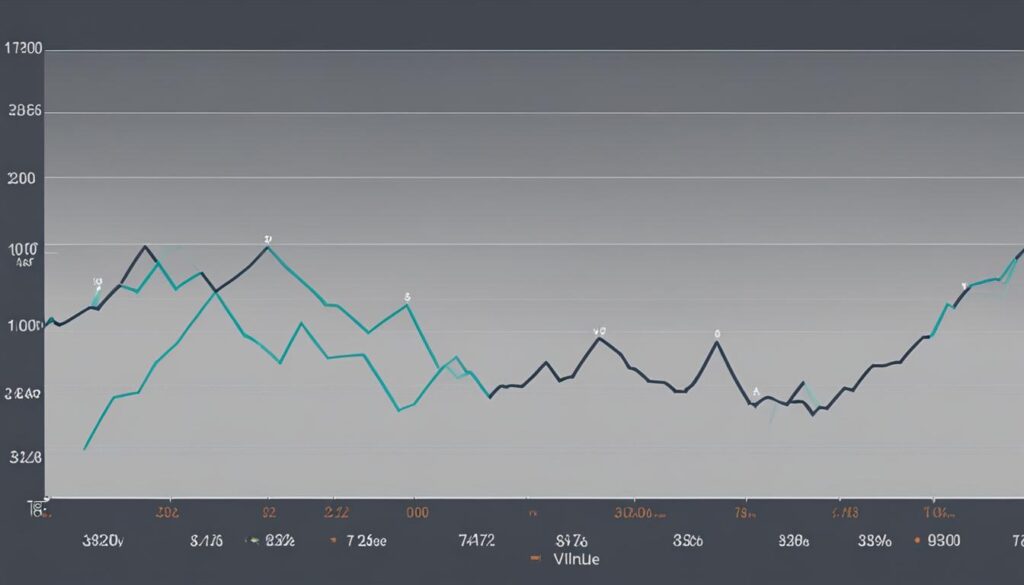If you’re new to investing and want to expand your knowledge of the stock market, it’s essential to learn how to read and understand stock charts. While it’s advisable to start with an investing guide for beginners and consider index funds or mutual funds for diversification and risk reduction, knowing how to interpret stock charts can improve your stock-picking skills. This comprehensive guide will break down the essentials of a stock chart and explain the key elements you need to focus on.
Key Takeaways:
- Stock charts are visual representations of a stock’s price movement over time.
- The trendline shows the general direction of the stock’s price movement.
- Lines of support indicate price levels that a stock is unlikely to drop below, while lines of resistance indicate price levels the stock is unlikely to go above.
- Dividends, stock splits, and trading volumes are important data points to consider when analyzing stock charts.
- Moving averages, support and resistance levels, and chart patterns provide insights into market trends and potential future price movements.
Understanding Stock Chart Basics
A stock chart is a visual representation of a stock’s price movement over time. It provides valuable insights into the historical performance and trends of a stock, allowing investors to make informed decisions about buying and selling.
The trendline is a key element of a stock chart, as it shows the general direction of the stock’s price movement. By drawing a trendline connecting the highs or lows of a stock’s price over a specific period, investors can identify whether the stock is in an uptrend or a downtrend.
In addition to the trendline, it is important to identify the lines of support and resistance in a stock chart. A line of support indicates a price level at which the stock is unlikely to drop below, as it represents a point where buyers are willing to step in and purchase the stock, creating demand. On the other hand, a line of resistance indicates a price level at which the stock is unlikely to go above, as it represents a point where sellers are willing to sell the stock, creating supply. These lines help investors determine potential buying and selling opportunities.
Here is an example of a stock chart with a trendline and lines of support and resistance:
| Date | Open | High | Low | Close |
|---|---|---|---|---|
| Jan 1 | 10 | 12 | 9 | 11 |
| Jan 2 | 11 | 14 | 10 | 13 |
| Jan 3 | 13 | 15 | 12 | 14 |
| Jan 4 | 14 | 16 | 13 | 15 |
| Jan 5 | 15 | 18 | 14 | 17 |
| Jan 6 | 17 | 20 | 16 | 19 |
By analyzing the stock chart, an investor can visualize the stock’s price movement, identify trends, and determine potential levels of support and resistance.
Now that you understand the basics of reading a stock chart, let’s dive deeper into analyzing trends and indicators to further enhance your stock market analysis.
Analyzing Trends and Indicators
When it comes to reading stock charts, there are several key data points that go beyond the trendline and lines of support and resistance. Understanding these additional indicators can provide valuable insights into a stock’s performance and potential future price movements. In this section, we will explore three important indicators: dividends, stock splits, and trading volumes.
Dividends
Dividends are cash payments made by companies to their shareholders as a reward for owning their stock. These payments can be observed in a stock chart and can significantly impact an investor’s return. Dividends are usually paid out quarterly or annually and are typically expressed on the chart as a downward adjustment in the stock’s price. Investors often look for stable or increasing dividend payments as a sign of a healthy company.
Stock Splits
A stock split occurs when a company decides to increase the number of shares outstanding while simultaneously reducing the share price. The purpose of a stock split is to make the shares more accessible to a wider range of investors. Stock splits are visually represented on a stock chart as a sudden decrease in the share price and an increase in the number of shares outstanding. While the overall value of the investor’s holdings remains the same, stock splits can create more liquidity in the market and potentially attract new investors.
Trading Volumes
Trading volumes refer to the number of shares traded during a specific period. It is a crucial indicator of investor activity and can help identify significant price changes or news events. High trading volumes often coincide with important announcements, such as earnings releases or news about mergers and acquisitions. Analyzing trading volumes can provide insights into market sentiment and help investors understand the level of interest and participation in a particular stock.
By considering these additional indicators, investors can gain a more comprehensive understanding of a stock’s performance and make more informed investment decisions. Dividends, stock splits, and trading volumes all contribute to the overall picture presented by a stock chart, allowing investors to assess a company’s financial health and market sentiment.
Interpreting Chart Patterns
When analyzing stock charts, it’s important to look beyond individual data points and focus on the broader patterns that emerge. Interpreting chart patterns can provide valuable insights into market trends and potential future price movements. Two key elements to consider are moving averages and support and resistance levels.
Moving averages are a useful tool for smoothing out the price data in a stock chart and identifying trends. They provide a more reliable picture of a stock’s performance by removing short-term fluctuations. By calculating the average price over a specific period, moving averages can help investors identify the overall direction of a stock’s movement. For example, a rising moving average indicates an uptrend, while a falling moving average suggests a downtrend. This information can be valuable when making investment decisions.
Support and resistance levels are price levels that a stock tends to bounce off. They indicate areas where buyers (support) or sellers (resistance) are particularly active. Support and resistance levels can act as barriers to price movements, creating trading opportunities. When a stock price approaches a support level, it is more likely to reverse its downward trend and start rising. Conversely, when a stock price approaches a resistance level, it is more likely to reverse its upward trend and start declining.
Chart patterns can also provide insights into market trends and potential future price movements. Here are a few common patterns to watch out for:
- Golden Cross: This pattern occurs when a short-term moving average crosses above a long-term moving average. It is considered a bullish signal and indicates a potential upward trend.
- Death Cross: On the other hand, the death cross is the opposite of the golden cross. It happens when a short-term moving average crosses below a long-term moving average. This bearish signal suggests a potential downward trend.
- Double Top: The double top pattern forms when a stock price hits a resistance level twice, fails to break through, and starts to decline. It is seen as a reversal pattern and can indicate a potential trend reversal from bullish to bearish.
- Head and Shoulders: This pattern consists of three peaks, with the middle one (the head) being higher than the other two (the shoulders). It indicates a potential trend reversal from bullish to bearish, with the neckline acting as a support level.
Understanding these chart patterns can give investors an edge in identifying potential market opportunities and making informed investment decisions.
Tools and Resources for Stock Chart Analysis
Once you have a good understanding of reading stock charts, you may want to explore more advanced tools and resources for stock chart analysis. Online brokers and robo-advisors offer various charting features and analysis tools to help investors make informed decisions.
One popular option is Robinhood, an online broker known for its user-friendly interface and commission-free trading. With Robinhood, investors can access real-time stock charts and technical analysis tools to analyze market trends and make informed investment decisions. The platform also offers a wide range of educational resources, including webinars and tutorials, to help investors improve their stock chart analysis skills.
Another reputable option is Charles Schwab, a leading brokerage firm that provides a full range of brokerage and financial advisory services. Charles Schwab’s trading platform offers advanced charting tools and technical analysis indicators, allowing investors to conduct in-depth stock chart analysis. The platform also provides access to extensive research and analysis reports, helping investors stay informed about market trends and potential investment opportunities.
In addition to these online brokers, investors can also consider using robo-advisors for stock chart analysis. Robo-advisors, such as Betterment and Wealthfront, utilize algorithms and automated investment strategies to provide personalized investment recommendations. These platforms often include stock chart analysis tools as part of their portfolio management services, helping investors optimize their investment decisions based on market trends and historical data.
“Online brokers and robo-advisors offer convenient and accessible tools for investors to analyze stock charts and make informed investment decisions.”
Online Brokers and Robo-Advisors for Stock Chart Analysis
| Platform | Description | Features |
|---|---|---|
| Robinhood | An online broker with a user-friendly interface and commission-free trading. |
|
| Charles Schwab | A full-service brokerage firm offering a wide range of financial services. |
|
| Betterment | A robo-advisor that provides personalized investment recommendations. |
|
| Wealthfront | A robo-advisor offering automated investment services. |
|
By utilizing these stock chart analysis tools and resources, investors can enhance their decision-making process and increase their chances of success in the stock market.
Conclusion
Understanding how to read stock charts is a crucial skill for investors looking to make informed decisions in the stock market. By analyzing trends, identifying lines of support and resistance, and recognizing chart patterns, investors can gain valuable insights into a stock’s performance and potential future price movements. This beginner’s guide has provided an overview of the key elements of stock chart analysis, equipping you with the knowledge to navigate the stock market with confidence.
Continual education and staying up-to-date on market trends and indicators are essential for success. As you expand your knowledge and experience, you can explore advanced tools and resources, such as online brokers and robo-advisors, to enhance your stock chart analysis. Platforms like Robinhood, known for their user-friendly interface and commission-free trading, and Charles Schwab, offering a comprehensive range of brokerage and financial advisory services, can be valuable allies in your investment journey.
Remember, the stock market is dynamic, and no one can predict its movements with certainty. However, a solid understanding of stock charts can provide valuable insights and guide your decision-making process. Stay disciplined, conduct thorough research, and remain patient and adaptable. With dedication and a commitment to ongoing learning, you can become a more successful investor in the dynamic stock market.
FAQ
What is a stock chart?
A stock chart is a visual representation of a stock’s price movement over time.
What is the trendline in a stock chart?
The trendline is a key element of a stock chart, showing the general direction of the stock’s price movement.
What are lines of support and resistance in a stock chart?
Lines of support indicate price levels that a stock is unlikely to drop below, while lines of resistance indicate price levels that a stock is unlikely to go above. These lines help investors determine when to buy or sell a stock.
What other key data points should I understand in a stock chart?
In addition to the trendline and lines of support and resistance, it’s important to understand dividends, stock splits, and trading volumes in a stock chart.
What are dividends in a stock chart?
Dividends are cash payments made by companies to their shareholders, which can be seen in the stock chart.
What are stock splits and how are they reflected in a stock chart?
Stock splits increase the number of shares and decrease the share price, and these events are reflected in the stock chart.
What does trading volume indicate in a stock chart?
Trading volumes provide information about the level of investor activity in a stock. High volumes often indicate significant news or price changes.
What are moving averages in a stock chart?
Moving averages are used to smooth out the price data in a stock chart and identify trends. They can be useful for analyzing stock chart patterns.
What are support and resistance levels in a stock chart?
Support and resistance levels are price levels that a stock tends to bounce off, and they are important to watch for potential trading opportunities.
What are some stock chart patterns that provide insights into market trends?
Some stock chart patterns that can provide insights into market trends and potential future price movements include golden crosses and death crosses.
What tools and resources are available for stock chart analysis?
Online brokers and robo-advisors offer various charting features and analysis tools to help investors make informed decisions. Some popular options include Robinhood and Charles Schwab.
Source Links
- https://www.moneyunder30.com/how-to-read-a-stock-chart/
- https://www.schwab.com/learn/story/how-to-read-stock-charts-and-trading-patterns
- https://www.nerdwallet.com/article/investing/how-to-interpret-stock-charts-and-data
Disclaimer
All information on this website is of a general nature. The information is not adapted to conditions that are specific to your person or entity. The information provided can not be considered as personal, professional or legal advice or investment advice to the user.
This website and all information is intended for educational purposes only and does not give financial advice. Signal Mastermind Signals is not a service to provide legal and financial advice; any information provided here is only the personal opinion of the author (not advice or financial advice in any sense, and in the sense of any act, ordinance or law of any country) and must not be used for financial activities. Signal Mastermind Signals does not offer, operate or provide financial, brokerage, commercial or investment services and is not a financial advisor. Rather, Signal Mastermind Signals is an educational site and a platform for exchanging Forex information. Whenever information is disclosed, whether express or implied, about profit or revenue, it is not a guarantee. No method or trading system ensures that it will generate a profit, so always remember that trade can lead to a loss. Trading responsibility, whether resulting in profits or losses, is yours and you must agree not to hold Signal Mastermind Signals or other information providers that are responsible in any way whatsoever. The use of the system means that the user accepts Disclaimer and Terms of Use.
Signal Mastermind Signals is not represented as a registered investment consultant or brokerage dealer nor offers to buy or sell any of the financial instruments mentioned in the service offered.
While Signal Mastermind Signals believes that the content provided is accurate, there are no explicit or implied warranties of accuracy. The information provided is believed to be reliable; Signal Mastermind Signals does not guarantee the accuracy or completeness of the information provided. Third parties refer to Signal Mastermind Signals to provide technology and information if a third party fails, and then there is a risk that the information may be delayed or not delivered at all.
All information and comments contained on this website, including but not limited to, opinions, analyzes, news, prices, research, and general, do not constitute investment advice or an invitation to buy or sell any type of instrument. Signal Mastermind Signals assumes no responsibility for any loss or damage that may result, directly or indirectly, from the use or dependence on such information.
All information contained on this web site is a personal opinion or belief of the author. None of these data is a recommendation or financial advice in any sense, also within the meaning of any commercial act or law. Writers, publishers and affiliates of Signal Mastermind Signals are not responsible for your trading in any way.
The information and opinions contained in the site are provided for information only and for educational reasons, should never be considered as direct or indirect advice to open a trading account and / or invest money in Forex trading with any Forex company . Signal Mastermind Signals assumes no responsibility for any decisions taken by the user to create a merchant account with any of the brokers listed on this website. Anyone who decides to set up a trading account or use the services, free of charge or paid, to any of the Broker companies mentioned on this website, bears full responsibility for their actions.
Any institution that offers a service and is listed on this website, including forex brokers, financial companies and other institutions, is present only for informational purposes. All ratings, ratings, banners, reviews, or other information found for any of the above-mentioned institutions are provided in a strictly objective manner and according to the best possible reflection of the materials on the official website of the company.
Forex/CFD trading is potentially high risk and may not be suitable for all investors. The high level of leverage can work both for and against traders. Before each Forex/CFD investment, you should carefully consider your goals, past experience and risk level. The opinions and data contained on this site should not be considered as suggestions or advice for the sale or purchase of currency or other instruments. Past results do not show or guarantee future results.
Neither Signal Mastermind Signals nor its affiliates ensure the accuracy of the content provided on this Site. You explicitly agree that viewing, visiting or using this website is at your own risk.




